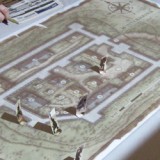Virtual Room
What do you get when you mix two of Media Geeks’ favorite modern forms of entertainment, escape rooms and Virtual Reality? You get Virtual Room, of course, an apt name (albeit not very creative) if there ever was one. Promising to let you solve your way through fantastic worlds that could never be built in real life, Virtual Room boasts Collaborative VR that lets multiple people inhabit the same digital environment, which includes the ability to interact with each other.
Getting Ready
 In the middle of Hollywood Blvd., Virtual Room is surrounded by a lot of stuff competing for your attention, including the Beetlejuice and Star Wars-themed bars. I am curious how many pedestrians walking by would stop what they’re doing for an hour to try out this experience. Helpfully, they advertise a 5-minute demo on a signboard out front. The VR is limited to 4 people at a time, although they have capacity to run 2 games of 4 players simultaneously. My 3 friends joined me and the very friendly host showed us into our individual rooms. I love that each player gets their own room, allowing freedom of movement without worrying about running into anyone else.
In the middle of Hollywood Blvd., Virtual Room is surrounded by a lot of stuff competing for your attention, including the Beetlejuice and Star Wars-themed bars. I am curious how many pedestrians walking by would stop what they’re doing for an hour to try out this experience. Helpfully, they advertise a 5-minute demo on a signboard out front. The VR is limited to 4 people at a time, although they have capacity to run 2 games of 4 players simultaneously. My 3 friends joined me and the very friendly host showed us into our individual rooms. I love that each player gets their own room, allowing freedom of movement without worrying about running into anyone else.
Each player gets an HTC Vive dedicated VR headset and 2 paddles/handles. These only require the use of a trigger button, to open and close your virtual hands, so the controls are simple and easy for anyone to use. The earphones swing into place, the built-in microphone picks up your voice, and the next thing you know, you find your world dissolving into a futuristic control room and all 4 of you have been replaced by brightly colored floating robots.
Playing the Game
 A disembodied voice coming from an orb lays out our mission. We are in the year 2217 and time travel is possible now…but not always easy. The previous team sent back never returned, and we think they changed the past in such a way that our current reality is crumbling. The skies outside are an ominous red color, as flying cars zip past skyscrapers. Quickly donning our gear, this setup stage is a great way to get used to the controls, under the guise of gameplay.
A disembodied voice coming from an orb lays out our mission. We are in the year 2217 and time travel is possible now…but not always easy. The previous team sent back never returned, and we think they changed the past in such a way that our current reality is crumbling. The skies outside are an ominous red color, as flying cars zip past skyscrapers. Quickly donning our gear, this setup stage is a great way to get used to the controls, under the guise of gameplay.
After we’re all ready to go, we punch in the first destination to our wrist-mounted control pads and the world again shatters into triangles against a ring of blue light.
There are 4 stages to Mission One, each of which has an 8-minute time limit. You will be taken to the next phase after those 8 minutes are up ,whether you succeed or not. So there is a bit of ticking clock pressure, like real-world escape rooms. Only now this happens several times, instead of just once at the end. The various environments are beautiful and diverse. The first thing we all did after every time jump was Ooh and Aah at the scenery before turning our attention to what we could solve or manipulate. We quickly learned that although we shared one environment, the game largely found ways to keep us separated. So we could talk to each other, but there were no high-fives to be done, and few multiplayer problems to solve. There was some interaction though. Players can pick up objects and throw them to each other. Catching projectiles proved to be a challenge, but we did get better at it.
Growing Pains
I’ve done one room that incorporated a little VR, with a headset, and I know there are others that incorporate it, but this is the only full-blown shared VR escape I’ve heard of. The company is based in France, where they have a dozen locations, and are rolling out a second location in the US soon (New York). They’ve even got locations in South America, Australia, and Singapore, and with a pending partnership with a big tech company, Virtual Room is well on their way to bigger and better things. I can’t wait because while the fun factor for Mission One was extremely high, it disguises a few things that could be improved. As an escape room, the limitations of the VR technology are apparent in the relatively simple puzzles and few chances to work together. Exchanging objects with each other is fun, but a bit challenging with the controls and has limited usefulness. Although I will commend the physics of throwing the objects, which changes based on your motion and even the environment’s gravity. If you’re just looking for a pure escape room, this is likely not the best option.
The VR is beautiful and largely functions smoothly. Unfortunately, our game did have a couple of glitches that required resets. Luckily they didn’t take long, and we still got to play through the end of the game. Two of my friends experienced minor glitches that I couldn’t see, and there was one major error that affected our whole team. Some of the VR included mini games, which were fun, and different kind of puzzles than would be possible in the real world. Since Mission One is not strictly a game, that aspect can’t quite live up to something like The Void. It’s not really a knock to say it’s not the best escape room, nor the best VR game. Combining two things in a new way can’t be expected to be the best of both worlds right out of the gate.
The Future
Virtual Room will be launching a second adventure within the next couple of months. So (drum roll please)…would I go back? Yeah, I would! Even if it’s not the best escape, or the best VR, you can’t discount the fun factor. And it really was fun! Plus, the second Mission can only improve on the first one as the company learns and advances. Like Alien Zoo, this hybrid form of entertainment is cutting-edge and will only become more prevalent. Active VR is the future and Virtual Room is a trailblazer. Plus, at $28 on weekdays and $35 on weekends, it’s less expensive than some premium escape rooms, and suitable for the entire family.
Virtual Room is open every day from noon until late night. More information, and ticketing, can be found at their website.


















